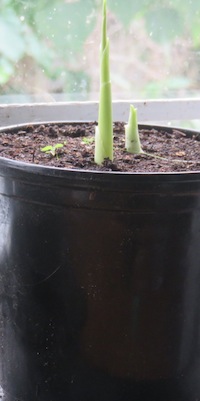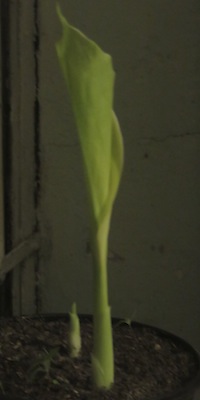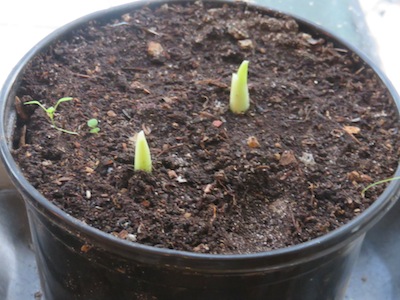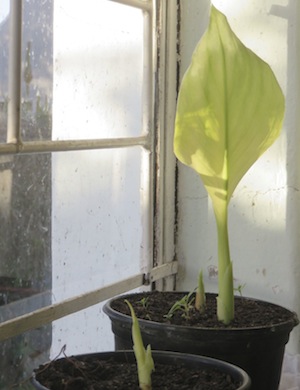Dear Reader, in this age of AI created content, please support with your goodwill someone who works harder to provide the human-made. Sign up at the top of the lefthand column or bottom of this page. You will receive my hand illustrated monthly newsletter RESTORE NATURE and access to the biodiversity garden design course as I write...and nothing else, I respect your time. I am also removing the advertizing as best I can as its become intrusive inappropriate and pays me nothing.
How to grow turmeric rhizomes
Turmeric rhizomes are relatively easy to grow. The yellow powder we use for cooking is ground from the dried root, therefore to grow fresh turmeric you will need to plant some fresh rhizomes and allow them to multiply, like other garden rhizomes, and then harvest the new ones at the end of the season when the foliage dies back.
The turmeric plant belongs to the Zingiberales, one of the monocot orders in botanical classification. The different families in this order include cardamom, ginger (hence the name Zingiberales), cannas (Cannaeceae), bananas (Musa), Strelitizias and a plethora of what we know as tropical indoor plants with lovely foliage and strange flowers such as spiral ginger (Costus), Heliconi, Orchidantha and Meranta. There is a link below at the bottom of the page to pictures of the gorgeous and sometimes quite bizarre flowers of this plant family.
I find it hard to absorb all the hairsplitting discussions in taxonomy, but the cultural connections intersecting with food plant groupings and geographical location, such as the enormous diversity of Solanum foods in Meso America are quite fascinating to a plant lover. There seems to be quite diverse use of Zingiberales in tropical Asia, as well as more than one variety of our well known spices like cardamom. I’ve set about growing turmeric and ginger. So far the ginger has been less rewarding. The processes of sprouting rhizomes is slower than most authors online will divulge, especially if you have pot on a window sill in winter.
I bought some fresh turmeric rhizomes recently. They are not easy to find, but we have a great food culture in Cape Town and I bought them from Salt River market, which sells fresh Taro (or Amadumbes in South Africa), and many other wonderful ingredients one normally only finds in a processed form. On my next trip to Salt River I will look for ripe plantains, or cooking bananas, as they have seed, whereas the usual sweet bananas in our vegetable shops are seedless.
 Turmeric on 12th June Turmeric on 12th June |
 25th June 25th June |
How to grow turmeric rhizomes
I planted the turmeric rhizomes in pots and adhering to online
instructions didn’t overwater them. This was on the 21st of April
and the first little points of leaf shoots emerged on the 2nd of June,
approximately forty days later, rather longer than the two weeks suggested by my
online research. They then took about 26 days to open up the first leaf. Four
out of five roots produced shoots which is a pretty good result. However on
emerging fully their palour shows me that something is wrong. More research
suggests that it is nutritional deficit because turmeric is a heavy feeder. My
fifty fifty sand manure mix just isn’t rich enough. I’ve started organic
supplements, using urine for Nitrogen and some kelp granules I found in a
drawer. The green seems to be picking up slightly. Turmeric likes acid soil, so
I’m wary of adding ash to supply them with Potassium as it increases pH. I must
buy bone meal and some granite dust for the rest of the major nutrients.
I wish I had a grey water outflow channel organized. From local permaculturists I learned how they feed greywater into channels filled with sawdust which allow the extra high levels of nitrogen to be absorbed and degrade, and in this process for the excessive phosphates in the detergents that come in most grey water to become plant nutrients in the garden rather than in a river where they cause toxic algal blooms and are severe polluters. It sounds like turmeric could make excellent use of these extra nutrients. It doesn’t like to be too soggy though. I’m imagining a system that may work with taro or amadumbe planted really close to the grey water outflow and planting turmeric nearby where it is rich but not too wet, so that its roots can get at the nutrients without the turmeric rhizomes, which we use, rotting from too much dampness.
In addition to being a lovely base spice in a lot of Asian cuisines, from Iran to Indonesia, fresh as well as dried and powdered turmeric rhizomes have a host of beneficial health benefits, and there is a lot of material on the net on health and turmeric. For an initial ‘taste’ of the health benefits see the link below.
------
home page with lots of useful hints on natural gardening
------
growing food plants for natural gardens
------
an album of bizarre, beautiful Zingiberales flowers
------
health benefits of turmeric consumption
You’re a home gardener ! Share your experiences and questions !
We all know about home gardening. Tell us about your successes, challenges and ask about issues that bother you. You may have the luxury of a back garden, but there are other ways we learn. Few people age without growing something or buying vegetables during their lives ! It is absolutely guaranteed that you have learned things which can help others on their gardening journey.
We invite you to share your stories, ask questions, because if a thing has bothered you it will bother others too. Someone may have a solution ! No question is too small. There is learning for everyone involved, for you, for me (yes, I learn from every question), for us all. Exciting stuff !
We are starting on a new journey. Every week we will profile your letters ! The best stories and questions we receive.
What Other Visitors Have Said
Click below to see contributions from other visitors to this page...
day one and two of fertilization program 




Pity at my turmeric's palour started me with 1 to 10 diluted urine, as missing nitrogen can cause palour. It seemed to have no effect for about four days, …
Restore Nature Newsletter
I've been writing for four years now and I would love to hear from you
Please let me know if you have any questions, comments or stories to share on gardening, permaculture, regenerative agriculture, food forests, natural gardening, do nothing gardening, observations about pests and diseases, foraging, dealing with and using weeds constructively, composting and going offgrid.
SEARCH
Order the Kindle E-book for the SPECIAL PRICE of only
Prices valid till 30.09.2023
Recent Articles
-
garden for life is a blog about saving the earth one garden at a time
Apr 18, 25 01:18 PM
The garden for life blog has short articles on gardening for biodiversity with native plants and regenerating soil for climate amelioration and nutritious food -
Cape Flats Sand Fynbos, Cape Town's most endangered native vegetation!
Apr 18, 25 10:36 AM
Cape Flats Sand Fynbos, a vegetation type found in the super diverse Cape Fynbos region is threatened by Cape Town's urban development and invasive alien plants -
Geography Research Task
Jan 31, 25 11:37 PM
To whom it may concern My name is Tanyaradzwa Madziwa and I am a matric student at Springfield Convent School. As part of our geography syllabus for this
"How to start a profitable worm business on a shoestring budget
Order a printed copy from "Amazon" at the SPECIAL PRICE of only
or a digital version from the "Kindle" store at the SPECIAL PRICE of only
Prices valid till 30.09.2023










